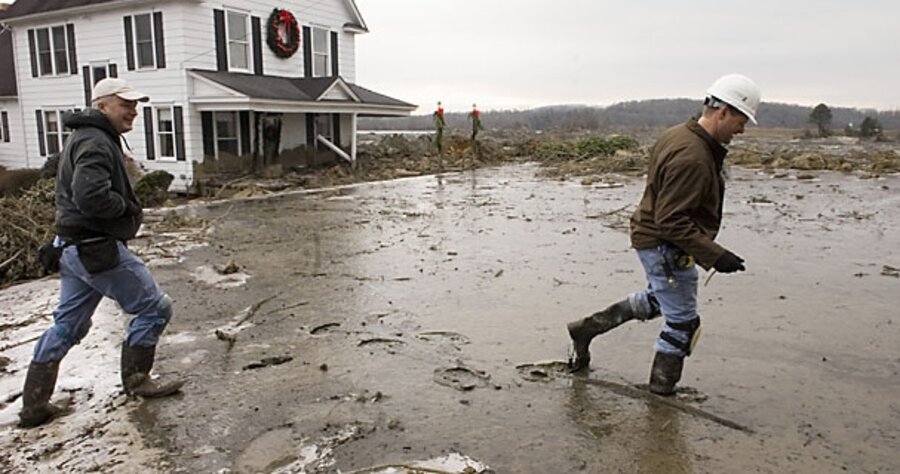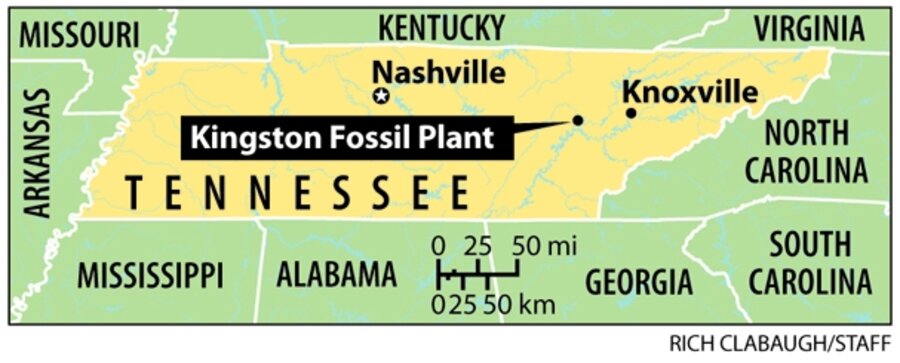Tennessee spill revives coal ash controversy
Loading...
| Chicago
Each summer, Rick Cantrell liked to pull up catfish off the dock behind his sister’s house on Clinch River, a seasonal ritual that often lasts until the early hours of the morning.
That ended the Monday before Christmas when a retaining wall broke at a Tennessee Valley Authority (TVA) coal-fired power plant, releasing into the wild 5.4 million cubic yards of toxic sludge. In one day, the sludge destroyed several homes, the property values of the immediate region, and a way of life.
“There’s no water anymore. There’s no dock there anymore. It’s all gone,” said Mr. Cantrell.
Residents in this East Tennessee mountain valley of intersecting waterways and lush vistas are still adjusting to the realization that life may never be the same following what some say could be the largest environmental disaster in US history.
Occurring within weeks of a new administration taking office in Washington, the disaster has brought attention to the regulation of the storage and disposal of waste coal. Environmentalists hope it will lead to a reexamination of coal as clean energy.
Photographs show hundreds of acres of land caked in what looks like thick, porous mud but is actually water-soaked coal ash, the byproduct of coal combustion. The TVA claimed about 400 acres were covered in the sludge, said the TVA. According to the EPA, enough coal ash was released to cover more than 3,000 acres with sludge one foot deep. [Editor's note: The original paragraph misstated the area covered by the sludge.]
“[The waste] turned one of the most beautiful places in this country into a giant slag heap,” Mr. Irwin said.
The Kingston Fossil Plant at Harriman, located 40 miles west of Knoxville, is now surrounded by emergency crews, clean-up contractors, environmental groups, and homeowners, working to determine what caused the break and what harmful chemicals may have infected the water and, potentially, the air.
So far, “very high” traces of arsenic, lead, and thallium have been found in the Emory River a mile and a half downstream from the plant, said Laura Niles, spokesperson for the Environmental Protection Agency (EPA). The toxins, which are known to cause birth defects and nervous and reproductive disorders, pose significant risk since the Emory River feeds into the Clinch River and the Tennessee River.
Residents are being cautioned against drinking tap or well water although Ms. Niles said the toxins had not yet been found near the water treatment plant near Kingston. John Moulton, spokesperson for the TVA, said the company is building an underwater rock wall at the base of the Emory River to catch sediment.
The bulk of the coal ash “is inert,” he said, adding that if higher than normal levels of metal were found in the water, it would be filtered out by the treatment plant.
As sampling continues, the disaster has renewed the debate over the efficiency of coal power and the EPA’s role in regulating storage and distribution of its waste.
At least half of all electrical power in the US is generated by coal-fired power plants, located mostly in the Southeast. In 2007, electric utilities and independent power producers consumed about 1 billion tons of coal, representing 93 percent of all coal produced in the US that year.
The high consumption results in about 125 million tons of waste, which is traditionally cooled and stored in landfills.
Critics say the EPA failed to create national standards for waste storage due to opposition from utility companies and the coal industry. With responsibility handed off to state agencies, standards vary widely, resulting in the phenomenon of “importing pollution” from a highly regulated state to one with lower standards, according to Carrie La Seur, president of Plains Justice, an environmental law center in Cedar Rapids, Iowa.
“It’s really been a federal failure to regulate this waste stream that has resulted in this patchwork,” said Ms. La Seur. “You get ... a ‘race to the bottom.’ Every state has the perverse incentive to create the loosest regulation to attract whatever businesses are available.”
Because the EPA was reluctant to classify coal ash as hazardous during the Clinton administration, companies are not required to store coal ash in lined landfills. The Kingston facility stores its waste in unlined ponds with just a retaining wall separating it from the Emory River.
TVA’s Mr. Moulton said the company is reconsidering how coal ash is stored and disposed at the Kingston plant.
Due to the sheer volume of waste produced, the coal industry has been advocating recycling the material into backfill and building materials such as cement, bricks, or wallboard.
About 60 percent of the approximately 600 coal plants in the US are designed to recycle coal waste, unlike older plants like Kingston, says David Goss, executive director of the American Coal Ash Association. But only about 45 percent of coal ash gets reused.
“It’s not the norm yet,” said Mr. Goss, adding that that is likely to change as utility companies realize the revenue potential of marketing their waste for byproducts. However, it’s not clear if coal ash can be effectively recycled without leaching toxins into groundwater or the air.






